Pilot Highly Protected Marine Areas: de minimis assessment
Updated 25 May 2023
Applies to England
Title of measure: Pilot Highly Protected Marine Areas (HPMAs)
Lead department or agency: Department for Environment, Food and Rural Affairs (Defra)
Expected date of implementation: 5 July 2023
Origin (domestic or international): Domestic
Date of assessment: 21 February 2022
Rationale for intervention and intended effects
The UK has a large marine area that is rich in marine life and natural resources, with a mainland coastline of nearly 18,000 km and an exclusive economic zone (EEZ) of nearly 900,000 km2. The UK’s marine environment is important in terms of biological diversity, but it also provides us with a variety of goods and services, such as:
- recreation and tourism opportunities[footnote 1],[footnote 2](and associated income and wellbeing)
- the provision of marine products [footnote 3],[footnote 4] (for example, fish and shellfish)
- regulating services [footnote 5] (for example, climate regulation, flood mitigation and coastal protection)
- cultural [footnote 6] and existence values [footnote 7]
This makes the marine environment essential to our social, economic, and environmental wellbeing [footnote 8].
However, market failures have led to the overconsumption and under protection of our marine environment. For example, negative externalities (costs to a third party incurred through the production or consumption of goods or services) occur when damage to the marine environment is not fully accounted for by users and no compensation is paid. In many cases there is no market for marine goods and services meaning no monetary price is attached to them and the cost of any damage is not captured by the market. Another example is that some goods and services provided by the marine environment, such as climate regulation and biological diversity are ‘public goods’.
The defining features of a public good is that no one can be excluded from benefiting from these goods or services and that consumption of the good or service does not diminish its availability to others.
This means that individuals and businesses do not necessarily have an economic incentive to voluntarily contribute effort or money to ensure the continued existence of these goods.
Whilst the current network of Marine Protected Areas (MPAs) play an important role in conserving species and habitats, some areas require a higher level of protection to restore them to a fully recovered condition or to prevent their deterioration. The designation of pilot HPMAs will therefore address these market failures to a greater extent than existing MPAs by taking a whole-site approach to prohibiting activities and pressures that prevent ecosystems (rather than just features) from recovering fully.
Industry would not be able to provide this as the protection of the marine environment requires coordination and enforcement that is not possible within markets. There is also a lack of incentives for market agents to protect the marine environment as activities which cause damage are likely to be beneficial to businesses in the short and medium-term.
The objective of this policy is to protect and recover ecologically valuable habitats and species, to deliver long term benefits for users and non-users of the marine environment. Pilot HPMAs will do this by setting aside some areas of the sea with high levels of protection, prohibiting extractive, depositional and destructive activities in certain marine areas. Sites for pilot HPMAs were selected based on ecological, social and economic criteria to maximise biodiversity benefits while minimising impacts to sea users.
Viable policy options (including alternatives to regulation)
This De-Minimis Assessment (DMA) considers the designation of pilot HPMA sites in English waters using powers under the Marine and Coastal Access Act (MCAA, 2009). The following policy options were considered.
Non-regulatory option
No designation of any pilot HPMAs and instead stakeholders would need to unanimously agree to HPMA sites. Once agreed, stakeholders would cease activity in the site, but it would not be formally designated or enforced. This was not taken through to the shortlist as (1) getting unanimous stakeholder agreement on HPMA sites would not be possible, and (2) the stopping of stakeholder activity in the area would not be guaranteed. The former was evidenced by the Marine Conservation Zone reference area process. Peterborough and Sheffield. If any sites were selected, these were unlikely to be fit for the ecological objectives of the policy. This option is therefore not preferred.
Regulatory option (preferred)
Formal designation of at least one pilot HPMA site. Five candidate sites, and their different boundary options, were considered under this preferred regulatory option. Note, the difference between a site’s boundary options is the spatial coverage. The sites and our preference for their designation is summarised below:
- Site 1 – Allonby Bay (preferred). Three boundary options were identified but one was removed from consideration at the long list stage. Option C is preferred because it provides high ecological benefits but allows key angling activity (which is socially and economically important to the local community) to take place and meets the needs of Maryport and Port of Silloth.
- Site 2 – Dolphin Head (preferred). Two boundary options were considered. Option B is preferred as it provides high ecological benefits whilst minimising the social and economic costs relative to Option A.
- Site 3 – North East of Farnes Deep Option A (preferred). This site is preferred as it provides high ecological benefits that outweigh the low social and economic costs.
- Site 4 – Lindisfarne. This site is not preferred due to the likely very high social and economic costs to the local community.
- Site 5 – Inner Silver Pit South. Three boundary options were identified but one was removed from consideration before the long list stage. Neither of the remaining options are preferred as although they provide strong potential for recovery and therefore high ecological benefits, there is a high cost to fishers (and therefore a low Net Present Value, which compares benefits to costs over the appraisal period) associated with designating either of the site options.
In summary, the regulation option is preferred to non-regulation and do-nothing options. Within the regulation option, there are 3 HPMA pilot sites that are preferred for designation:
- Allonby Bay - Boundary Option C
- Dolphin Head - Boundary Option B
- North East of Farnes Deep - Boundary Option A (consulted boundary)
Description of novel and contentious elements (if any)
These will be the first HPMAs designated in the UK. They will use the same legislation as existing Marine Conservation Zones (the Marine and Coastal Access Act 2009) but have a more stringent conservation objective. HPMAs attract significant stakeholder interest and strong views from environmental Non-Government Organisation (NGOs) , commercial and recreational fishers, and others. EU governments have also responded to the consultation.
Assessment of impacts on business
The main businesses directly impacted are those in the fishing industry, through profit foregone (from no longer being able to fish in the HPMA site). Some fishers would be able to offset their profit foregone by fishing elsewhere. However, this could incur a cost to switch gears. These costs are monetised below.
Non-monetised costs include social costs from HPMAs, such as loss of jobs and mental health impacts, and public sector costs of monitoring and enforcement. For the latter, we do not expect any additional costs for offshore sites but we expect additional costs for the inshore sites. These costs would fall on Inshore Fisheries and Conservation Authorities (IFCAs). However the magnitude was uncertain at the time of this DMA. We do not monetise familiarisation costs, as a result of the consultation indicating this will not occur.
Other marine industries such as renewable energy, ports, aggregates, oil and gas and cables, are unlikely to be affected in the option sites.
HPMA consultation Annex B Candidate HPMA selection process
The main monetised benefits are an ongoing increase in ecosystem services, which are quantified in the monetised impacts section below.
Brief assessment of distributional impacts
There will be distributional impacts from these HPMAs. When considering the economic and social impact of candidate HPMA sites, we considered the communities living in areas where impacts from designation were most likely. This includes those residing in Middle Level Super Output Areas (MSOAs) which are directly attached to the HPMA and those residing in MSOAs which are directly attached to the ports where catch from the candidate site is currently landed, as these communities are likely to be economically dependent on the candidate sites. For our preferred sites the following local areas were identified:
- Allonby Bay - we considered the local area around the HPMA itself as well as the local areas around Maryport and Silloth ports.
- Dolphin Head - we considered the local area around Portsmouth and Shoreham-by-Sea ports.
- North East of Farnes Deep - we considered the local area around Shoreham-by-Sea, Hartlepool, Blythe, and Amble. Note, while Shoreham-by-Sea is not geographically near to the site, catch is landed here and therefore the local area is considered in our analysis.
Centre for Environment, Fisheries and Aquaculture (Cefas) assessed the social vulnerability of the coastal communities around candidate HPMAs. The purpose of this assessment was to infer the potential social impacts of a site designation, in line with the Benyon Review. For our preferred sites we found:
- Allonby Bay – Areas to be impacted by the pilot HPMA experience relatively elevated levels of deprivation considering income and employment, and are at fairly high risk of social vulnerability, with housing affordability being the main driver. However, the preferred boundary option minimises potential social impact whilst maintaining environmental benefits.
- Dolphin Head - Areas to be impacted by the pilot HPMA experience mixed levels of deprivation (Shoreham-By-Sea and Portsmouth have average and very high levels of deprivation respectively). The areas are at fairly high risk of social vulnerability, with social dependency and employment opportunities being the most likely drivers. Potential social impacts were weighed up against the benefits of designation, as discussed in in ‘Summary of monetised impacts’, and in doing so this site is preferred to designate. Mitigations of impacts is discussed in the next section.
- North East of Farnes Deep – Areas to be impacted by the pilot HPMA experience a varying degree of deprivation relating to income and employment, ranging from medium to concerning. The area around the ports impacted are at very high risk of social vulnerability, with all three considered factors (housing affordability, social dependency, and employment opportunity) likely to be key drivers. Potential social impacts were weighed up against the benefits of designation, as discussed in in ‘Summary of monetised impacts’, and in doing so this site is preferred to designate. Mitigations of impacts is discussed in the next section.
Sites not preferred for designation, Inner Silver Pit South and Lindisfarne, have high and medium levels of deprivation, respectively. One area impacted by Inner Silver Pit South is in the top 10% of deprivation locally and nationally (although the areas impacted also have a low risk of social vulnerability). Lindisfarne is however at high risk of vulnerability, where employment opportunities is a key driver of this.
Brief assessment of small business impacts
The main businesses directly impacted would be those in the fishing industry. According to Statista , all businesses in the UK fishing and aquaculture industries are small or micro as they have under 49 employees. This was supported by evidence collected during the consultation, which indicated that most fishing activity is conducted by small vessels with a small number of employees. There will be support available to aid any adaptation required, such as the Fisheries and Seafood Scheme, the UK Seafood Fund or other similar funds. Although support from these is not guaranteed, as businesses will need to apply for them through a competitive process, this could mitigate against the impact to small and micro businesses and support adaptation and diversification.
Brief assessment of wider impacts
A key wider impact is the environmental benefits from pilot HPMA site designation. HPMAs allow marine ecosystems to recover to a mature state. By taking a ‘whole site approach’ to designation, they protect all habitats and species in their boundaries, allowing the marine environment to thrive. The ecosystem services associated with this have been monetised as a social benefit of the policy.
There may be some non-UK impacts, with 9 countries outside of the UK likely to be affected by HPMA site designation. The countries affected by the designation of the sites considered would be Belgium, Germany, France, Ireland, the Netherlands, Denmark, Lithuania, Norway (not in European Union), and Sweden. For our preferred sites, Allonby Bay would impact UK vessels only, North East of Farnes Deep and Dolphin Head would impact both UK and non-UK vessels, where there is an even split for the former and a greater impact on non-UK vessels for the latter.
There would be a primary impact on competition of designating pilot HPMA sites, from the displacement of fishers from designated to alternative sites. If fishers already occupy the alternative sites there would be increased competition and overcrowding. However, this is a short-term impact where we would anticipate increased fish populations from HPMAs to spill into surrounding areas in the long-term based on our literature review of HPMAs benefits. Annex C Allonby Bay candidate HPMA factsheet (solwayfirthpartnership.co.uk) and ESVD.
Fishers and an organisation representing anglers have concerns about the impacts on displacement of activity, with the latter particularly concerned about the displacement of charter boats, which could lead to either a loss or change of employment. This would have a negative wellbeing impact, given the strong connection between individuals and their profession. Potential social impacts were weighed up against the benefits of designation, as discussed in in ‘Summary of monetised impacts’. The potential loss of access points for disabled anglers in Allonby Bay under the consulted boundary was assessed and an additional reason for the preferred boundary option.
We sought the views of the public on innovation implications (for example, if the policy could positively or negatively impact industry’s ability to innovate) during the consultation period. The only potential impact would be modification of fishing gear, which while possible or even necessary in principle is unlikely to be undertaken in practice for situations where fishers would be displaced onto others’ established fishing grounds.
We sought the views of the public on trade implications during the consultation period. We were informed during the consultation that local processing firms may be affected to a large extent as they are involved in the exporting of fish caught in England. However, the effect on trade overall is expected to be negligible.
Summary of monetised impacts
All the monetised impacts in this summary section, are for the preferred option. We use a 30-year appraisal period, rather than the typical 10 years. This is because HPMA implementation requires a large and concentrated upfront economic cost to a small number of businesses, whereas the benefits will be diffused over a much wider population. Some benefits related to habitat recovery will not be realised until 25or moreyears from site designation. This assumption is in line with HM Treasury Green Book guidance.
As discussed earlier, the monetised costs are ongoing profit foregone and one-off gear costs for fishers. For the former, our summary statistics used evidence from Cefas which included displacement analysis. However, other evidence sources were also used as supplementary evidence in the decision-making process (for example, Marine Management Organisation landings, and consultation evidence). The Equivalent Annual Net Direct Cost to Business (EANDCB) is below, which is used to determine proportionality of analysis (see ‘Rationale for producing a DMA’ section).
Table 1: Equivalent Annual Net Direct Cost to Business (EANDCB) (£,000, 2019 prices, 2020 present value) – High Cost
This price and present value base year follow Regulatory Policy Committee guidance for EANDCB and Business Net Present Value summary statistics.
| Preferred sites and boundary option | Profit foregone (£,000) | Gear switching cost (£,000) | Total (£,000) |
|---|---|---|---|
| Allonby Bay C | 24 | 4 | 28 |
| Dolphin Head B | 25 | 4 | 29 |
| North East of Farnes Deep | 3 | 0 | 3 |
Table 2 : Equivalent Annual Net Direct Cost to Business (EANDCB) (£,000, 2019 prices, 2020 present value) – Low Cost
This price and present value base year follow Regulatory Policy Committee guidance for EANDCB and Business Net Present Value summary statistics.
| Preferred sites and boundary option | Profit foregone (£,000) | Gear switching cost (£,000) | Total (£,000) |
|---|---|---|---|
| Allonby Bay C | 9 | 0 | 9 |
| Dolphin Head B | 10 | 0 | 10 |
| North East of Farnes Deep | 1 | 0 | 1 |
These costs result in the Business Net (benefits minus costs) Present Values (NPV) below, which assesses the net direct impact to businesses over the appraisal period (30 years). There are no direct benefits to business therefore this value is negative:
Table 3: Estimated Business Net Present Value (NPV) (£,000 2019 prices, 2020 present value)
| Preferred sites and boundary option | Business NPV low (£,000) | Business NPV high (£,000) |
|---|---|---|
| Allonby Bay C | -536 | -167 |
| Dolphin Head B | -558 | -187 |
| North East of Farnes Deep | -61 | -17 |
| Total | -1,155 | -371 |
The only monetised social benefit is ecosystem services. Marine ecosystem services include the goods (for example, fish harvests, water), services (for example, recreation, erosion control) and cultural benefits (for example, heritage values) that are derived from the marine environment. Habitats and species in the HPMA sites provide a range of ecosystem services. For example, some HPMA sites contain ‘blue carbon’ habitats which capture and store carbon, so provide carbon benefits, and honeycomb reefs and blue mussel beds provide water purification and coastal erosion protection. The present value (PV) of benefits, which considers the discounted benefits over the appraisal period (30 years), is shown below.
Table 4: Estimated Benefits Present Value (£,000 2020 prices, 2023 present value)
| Preferred sites and boundary option | Benefit Present Value low (£,000) | Benefit Present Value high (£,000) |
|---|---|---|
| Allonby Bay C | 9,000 | 54,000 |
| Dolphin Head B | 63,000 | 66,000 |
| North East of Farnes Deep | 44,000 | 46,000 |
| Total | 116,000 | 167,000 |
The benefits significantly outweigh the costs, so the Net Present Social Value, which subtracts the total (business and society) costs from the total benefits, is almost identical to the Benefits Present value.
Table 5: Estimated Net Present Social Value (£,000 2020 prices, 2023 present value)
| Preferred sites and boundary option | NPV low (£,000) | NPV high (£,000) |
|---|---|---|
| Allonby Bay C | 8,000 | 54,000 |
| Dolphin Head B | 62,000 | 66,000 |
| North East of Farnes Deep | 44,000 | 46,000 |
| Total | 115,000 | 166,000 |
Evaluation and monitoring
Prior to the designation of pilot HPMAs, monitoring and evaluation of biological, social, and economic processes and effects of pilot HPMAs will be commissioned according to The Magenta Book guidelines. In tax year 2023 to 2024 an external supplier will be appointed to undertake the evaluation of pilot HPMA sites. The commissioned partner will further develop the draft evaluation framework for pilot HPMA sites and will identify appropriate methods for undertaking process and impact evaluation, including options for identifying counterfactuals to pilot HPMA sites and undertaking collection of baseline data in tax year 2023 to 2024 . Defra will also work with the Joint Nature Conservation Committee (JNCC) , Natural England and Cefas to support ecological monitoring of HPMAs. Learning from evaluation outputs and ongoing monitoring will be embedded to inform decisions about future HPMA designation and management. Any designation of HPMAs referred to in this DMA is for the 3 first pilot sites only.
Rationale for producing a DMA (as opposed to an IA)
A DMA is required for a low cost or deregulatory measure, or for validating the cost to business where costs to business is below the £5 million annual cost to business threshold. Our policy’s direct cost to business (EANDCB) is sufficiently below the threshold and therefore we have completed a DMA, instead of an Impact Assessment (IA).
Clearance
Marine and Fisheries, Better Regulation Unit, Office for the Chief Economist and Chief Economist
February 2023
Annex A – candidate HPMA site maps
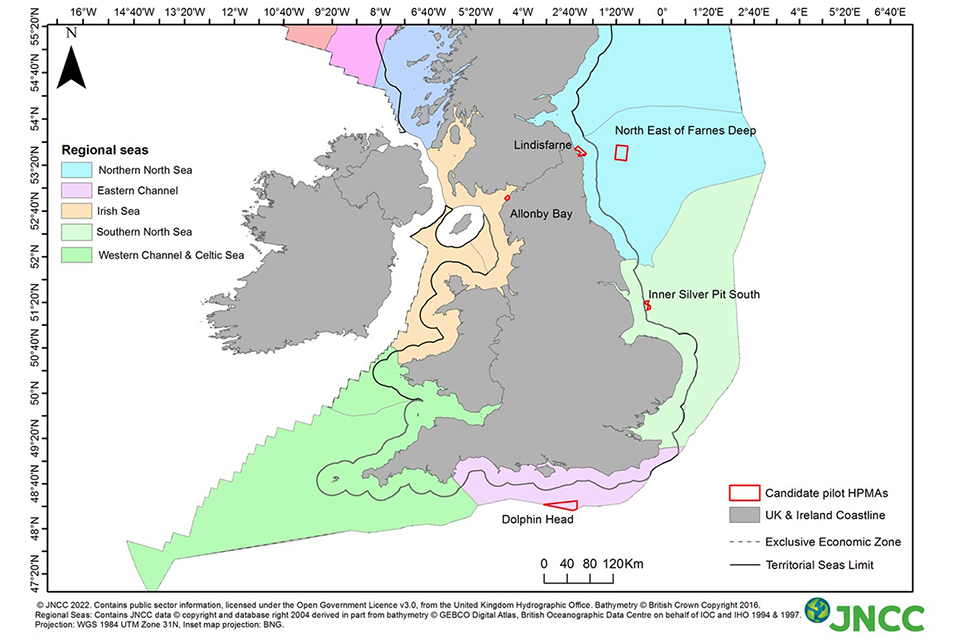
Figure 1 - Map outlining all five of the candidate HPMA site locations; Allonby Bay, Lindisfarne, North East of Farnes Deep, Inner Silver Pit South and Dolphin Head.
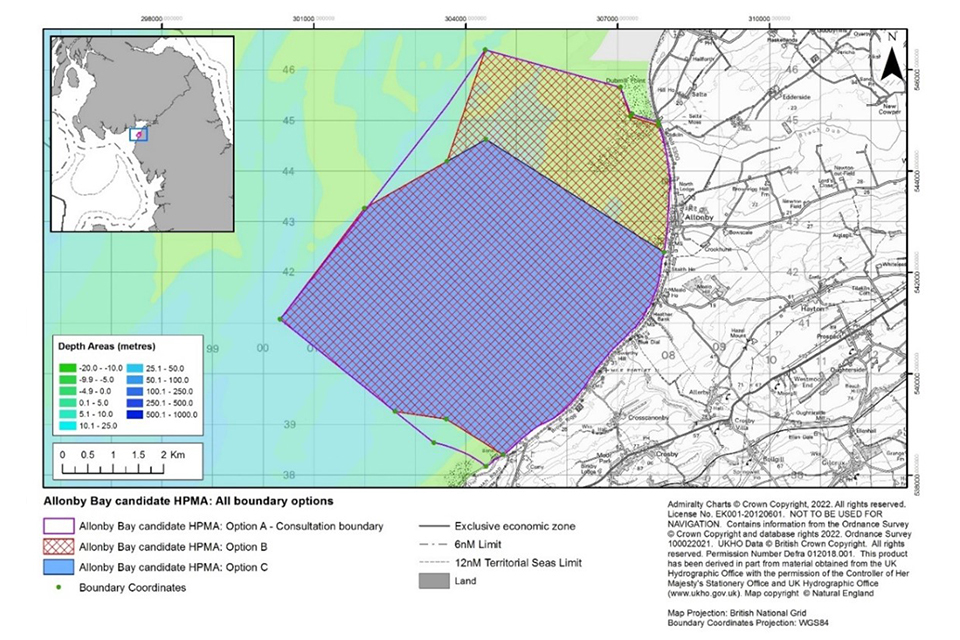
Figure 2 - The map shows 3 boundary options for the Allonby Bay site. Option A, the original consultation boundary (38.5 km2), Option B which excludes the Maryport Harbour and Port of Silloth (36.5 km2), and Option C, the preferred option which allows certain specified activities such as angling to continue to take place outside of the HPMA boundary (27.6 km2).
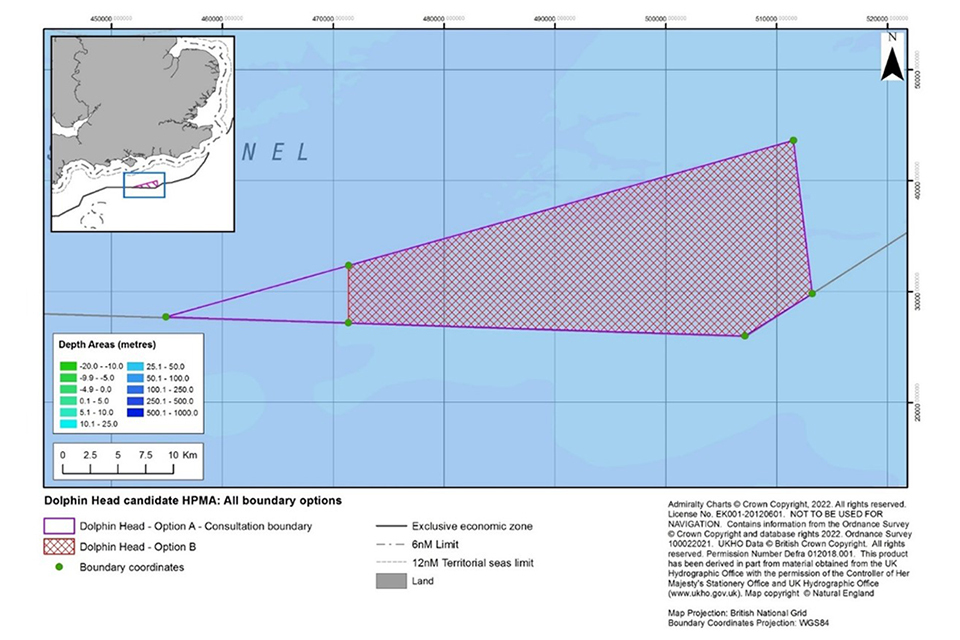
Figure 3 – Dolphin Head candidate HPMA: The map shows 2 boundary options for the Dolphin Head site. Option A, the original consultation boundary (508 km2) alongside Option B, the preferred option (462 km2) which excludes an area in the south-west corner facilitating compliance and enforcement by avoiding an acute angle in any final site boundary.
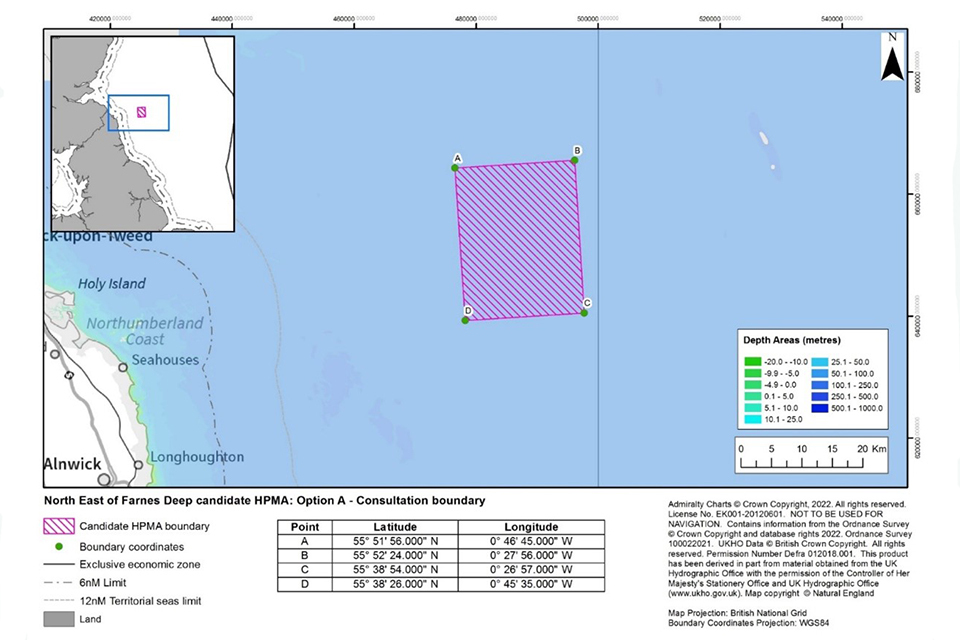
Figure 4 – North East of Farnes Deep candidate HPMA: This map shows Option A – the consultation boundary
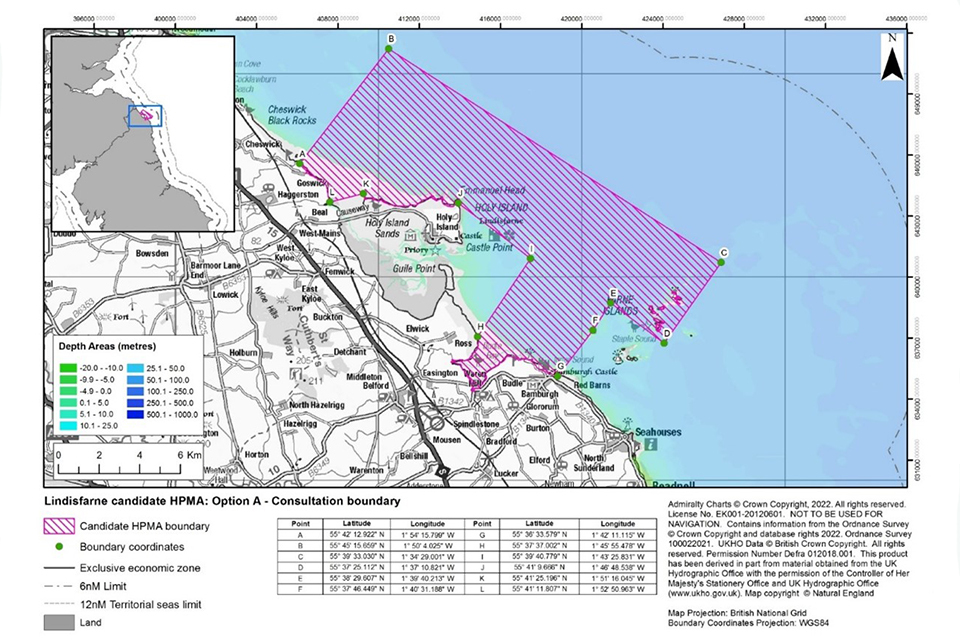
Figure 5 – Lindisfarne candidate HPMA: This map shows Option A – the consultation boundary

Figure 6 – Inner Silver Pit South candidate HPMA: this map shows 3 boundary options for the Inner Silver Pit South site. Option A shows the consultation boundary (62.5 km2). Option B, (53.03 km2) shows the removal of the northwest corner to exclude the location of a newly constructed cable. Option C (45.40 km2) includes amendments in Option B as well as a reduction in size of the northern extent.
-
Posford Duvivier. (1996). Financial Values of Five Important Marine/Coastal Wildlife Areas in England. Report to English Nature. ↩
-
Kenter, J. O., Bryce, R., Davies, A., Jobstvogt, N., Watson, V., Solandt, J., Duncan, C., Christie, M., Heather, C., Irvine, K. N., Pinard, M. and Reed, M. S. (2013) The value of potential marine protected areas in the UK to divers and sea anglers ↩
-
Posford Duvivier. (1996). Financial Values of Five Important Marine/Coastal Wildlife Areas in England. Report to English Nature. ↩
-
Luisetti, T., Turner, K. R., Bateman, Morse-Jones, S., Adams, C. and Fonseca, L. (2011) Coastal and marine ecosystem services valuation for policy and management: managed realignment case studies in England ↩
-
Luisetti, T., Turner, K. R., Bateman, Morse-Jones, S., Adams, C. and Fonseca, L. (2011) Coastal and marine ecosystem services valuation for policy and management: managed realignment case studies in England ↩
-
Ropars-Collet, C., Leplat, M., Le Goffe, P. and Lesueur, M. (2015) Commercial fishery as an asset for recreational demand on the coastline: evidence from a choice experiment in France, United Kingdom and Belgium ↩
-
Christie and Rayment (2012) An Economic Assessment of the Ecosystem Service Benefits Derived from the SSSI Biodiversity Conservation Policy in England and Wales ↩
-
Kenter, J. O., Bryce, R., Davies, A., Jobstvogt, N., Watson, V., Solandt, J., Duncan, C., Christie, M., Heather, C., Irvine, K. N., Pinard, M. and Reed, M. S. (2013) The value of potential marine protected areas in the UK to divers and sea anglers ↩
